How to convert a gas range to operate on LP gas
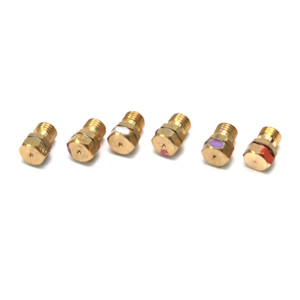
This DIY repair guide gives step-by-step instructions on how to convert a natural gas range to operate on liquid propane (LP) gas. Gas ranges typically come equipped to operate on natural gas. Install the LP conversion kit if you want to use LP gas. This guide is for reference only; carefully follow the instructions included with the manufacturer-approved LP kit to convert your range.
This guide shows how to convert some Kenmore, Frigidaire and Electrolux ranges to operate on LP gas.
How to install the LP conversion kit on your range to covert the range to use propane gas.
Instructions
- 01.
Shut off electricity and gas
At the breaker panel or fuse box, shut off power to the range. Turn the gas shut-off valve to the off position.
- 02.
Remove the grates, burner caps and burner heads
Remove all the cooktop grates and then lift the gas burner caps off the burner heads.
Using a 3/16-inch socket, remove the nuts that secure the gas burner heads in place.
Remove the burner heads from the cooktop.
Tip: Mark the burner caps and heads with a note indicating their location (Left Front, Right Front, Left Rear, Right Rear).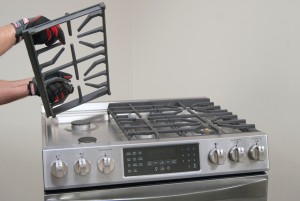
PHOTO: Remove the grates.
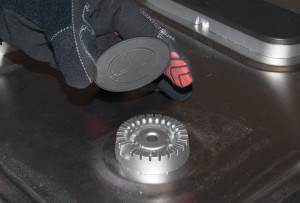
PHOTO: Remove the burner caps.
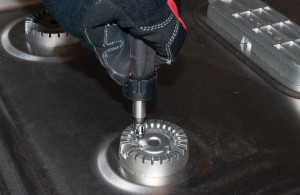
PHOTO: Remove the burner heads.
- 03.
Remove the natural gas orifices
Using a 7-mm nut driver, remove the orifices from the burner orifice holders.
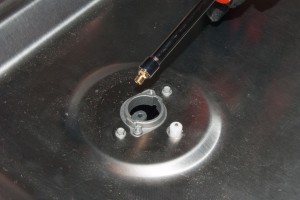
PHOTO: Remove the orifices.
- 04.
Install the LP orifices
Determine which LP orifices go to the range burners. Screw the LP orifices firmly onto the burner orifice holders.
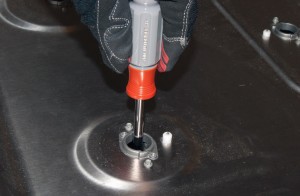
PHOTO: Install the LP orifices.
- 05.
Reinstall the burner heads, burner caps and grates
Position the burner heads in the correct locations.
Reinstall the burner head screws, tightening them firmly.
Cover the burner heads with the correct burner caps.
Reinstall the grates on the cooktop.
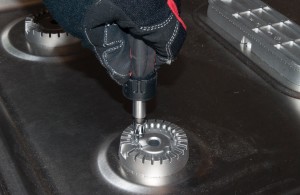
PHOTO: Reinstall the burner heads.
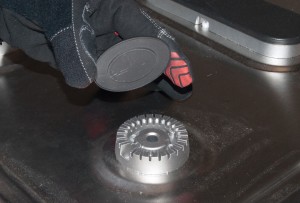
PHOTO: Reinstall the burner caps.
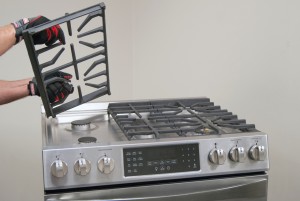
PHOTO: Reinstall the grates.
- 06.
Remove the warmer drawer
Open the warmer drawer fully.
Pull up on the left release lever and pull the warmer drawer out slightly.
Push down on the right release lever and pull the warmer drawer out of the range.
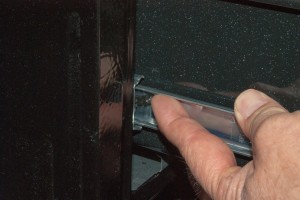
PHOTO: Push the left release lever up.
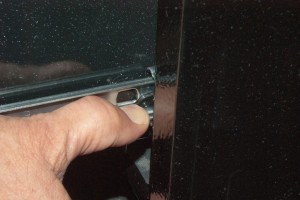
PHOTO: Push the right release lever down.
- 07.
Convert the pressure regulator
Using a wrench, unscrew and remove the hex nut cap on the pressure regulator.
Remove the plastic conversion plug.
Flip the conversion plug over and reinsert it into the pressure regulator.
Reinstall the hex nut cap.
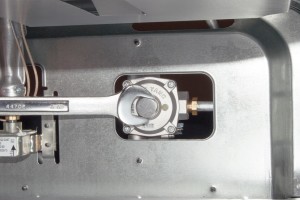
PHOTO: Remove the hex nut cap.
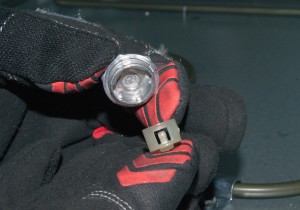
PHOTO: Remove the plastic conversion plug.
- 08.
Convert the oven broil burner
Position a wrench on the gas tube to hold it stationary.
Using a second wrench, tighten the broil burner orifice spud 1- 1/2 turns to bottom out snug against the burner tube. Do not over-tighten.
Loosen the air shutter lock screw and open the air shutter fully.
Tighten the air shutter lock screw.

PHOTO: Tighten the broil burner orifice.
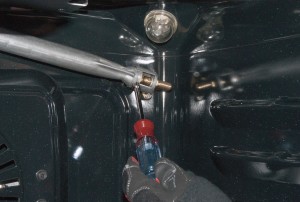
PHOTO: Loosen the air shutter screw.
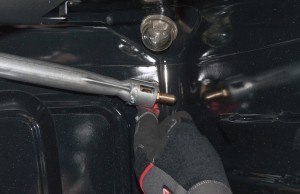
PHOTO: Open the air shutter.
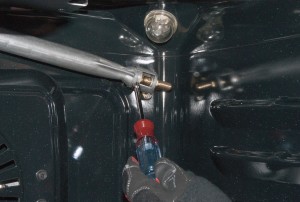
PHOTO: Tighten the air shutter screw.
- 09.
Convert the bake burner
Tighten the bake burner orifice spud 1- 1/2 turns to bottom out snug against the safety gas valve. Do not over-tighten.
Loosen the air shutter lock screw and open the air shutter fully.
Tighten the air shutter lock screw.
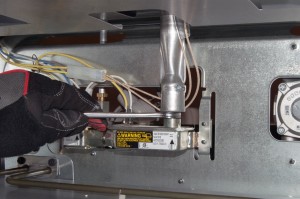
PHOTO: Tighten the bake burner orifice.

PHOTO: Loosen the air shutter screw.
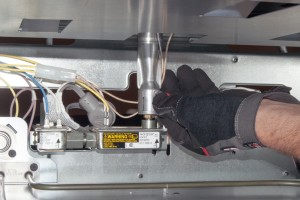
PHOTO: Open the air shutter.
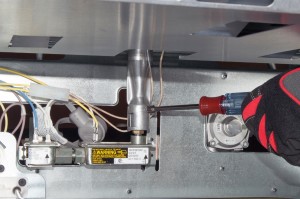
PHOTO: Tighten the air shutter screw.
- 10.
Reinstall the warmer drawer
Position the warmer drawer on the rails and push it shut.
- 11.
Reconnect gas and power
Switch on the electrical circuit breakers and the open the gas supply valve.
- 12.
Check the burners
Check all surface burners for a proper flame.
Test the oven burners and adjust the air shutters to achieve the proper flames.
Tip: If the oven flame is lifting away from the burner, reduce the air shutter opening.
Most common symptoms to help you fix your ranges
Choose a symptom to see related range repairs.
Main causes: broken oven door lock assembly, wiring failure, electronic control board problem…
Main causes: broken broiler element, weak or broken broil burner igniter, control system failure, faulty temperature sen…
Main causes: power supply problem, control thermostat or electronic control board failure, broken element, bad burner ig…
Main causes: bad bake element, broken burner igniter, control system failure, blown thermal fuse, faulty temperature sen…
Main causes: food splatters, spilling food on the oven door, allowing liquid to drip through oven door vent when cleanin…
Main causes: faulty temperature sensor, electronic control board problem, control thermostat failure, weak burner ignite…
Main causes: power supply failure, blown thermal fuse, bad relay control board, damaged terminal block, wiring failure…
Most common repair guides to help fix your ranges
These step-by-step repair guides will help you safely fix what’s broken on your range.

How to replace a range oven door switch
The oven door switch detects whether the oven door is closed and helps control the oven light. Replace the switch if it …
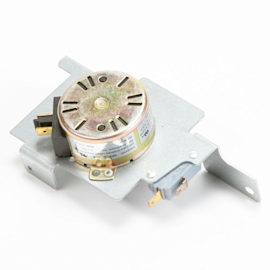
How to replace a range oven door lock assembly
Oven door not locking? You can replace the lock assembly in less than 30 minutes. Here's how.…
Effective articles & videos to help repair your ranges
Use the advice and tips in these articles and videos to get the most out of your range.

Learn how to clean and maintain your stove to keep it in top shape.…

Learn about all the convenient features on our Sears PartsDirect website that make your parts purchases easier.…

Get answers to frequently asked questions about Sears and Sears PartsDirect.…
